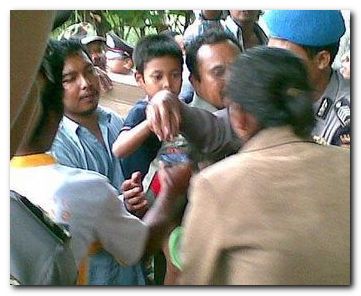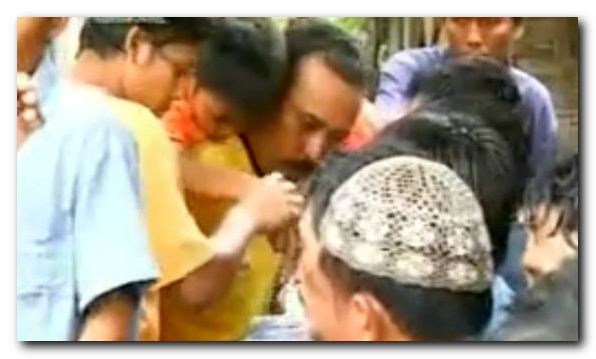M. Fajar
An image taken from one of the many clips of Ponari on youtube |
‘Dukun Cilik dari Jombang’, the Little Sorcerer from Jombang, is the boy’s nickname. Only nine years old, Ponari, born in Balongsari village, in the district of Jombang, East Java, is still at primary school, but he’s become famous in the past year.
It began with a lightning strike on December 12, 2008, says Ponari. In the middle of a hard rain, the lightning left behind a mysterious stone. According to Ponari and his followers, when he dunks the stone in water and the water is drunk by a sick person, it can heal the person’s illness. As the mass media coverage of his powers spread, so did Ponari’s popularity. First, it was just the people of Balongsari village who came to see him. Then, as word spread, large numbers of people, around 5000 per day, spilled out of Jombang and even travelled from the towns of Central Java to come and visit Ponari, each paying Rp.5,000 (US$ 0.5) to visit him.
Four people died, crushed by the crowds. For several months, every day the line would stretch hundreds of metres in front of Ponari’s house, as people waited for him to sink his stone into the glasses of water they brought with them. Those who could not wait in line scraped up soil from around his house and plastered it on their bodies, or collected water from his family’s well, hoping it would cure whatever ailed them.
The money that circulated in Balongsari village as a result of the Ponari phenomenon was estimated to be as much as one billion rupiah (US$100,000) per day
Ponari and his stone not only attracted people, but also attracted a large amount of money. The money that circulated in Balongsari village as a result of the Ponari phenomenon was estimated to be as much as one billion rupiah (US$100,000) per day. Most of this money went to local businesses, including local merchants who sold food, water and accommodation for those who wanted to wait in the queue to see the child healer. There was even a soft drink named after him, Ponari Sweat, evidently borrowed from the popular Pocari Sweat drink.
 |
An image taken from one of the many clips of Ponari on youtube |
 |
An image taken from one of the many clips of Ponari on youtube |
 |
An image taken from many about Ponari on Flickr |
For Ponari’s family, however, the story of Ponari’s success had a bitter side to it. Ponari’s life changed completely and his days became thoroughly consumed with healing, leaving no time for school or normal childhood activities, and leading to pressure from the National Commission for Child Protection. Ponari was even the centre of a quarrel between family members. In February 2009 the police shut down Ponari’s practice. His father, Khomsin, was beaten in a fight and hospitalised for trying to take Ponari away from the control of extended family members who wanted to reopen the practice.
A plethora of prophets
The Ponari phenomenon is not new. Before Ponari, there have been many miracle workers, alternative healers, and prophets who claimed to have magical powers to heal and bring good fortune. Lia Eden, for example, is a woman who proclaimed herself a prophet and tried to construct a new religion based on a blend of Islam and Christian doctrines. She was first known as Lia Aminuddin and declared herself as the heir of Muhammad, the last prophet in Islam. Her first public appearance was in 1998 when she claimed she was Imam Mahdi, a manifestation of the Islamic belief that a person will appear at the end of the world to spread peace and justice. She was jailed for two and a half years for blasphemy last June.
Another figure is Agus Solichin, a man who declared himself as a satrio piningit (saviour knight), a figure based on the legend of a person who will emerge to overcome goro-goro (great chaos). He first appeared in 2002 in Bekasi, West Java. He established a group with controversial teachings and rituals regarding sexual relations between husbands and wives. When protests occurred in 2009 about the rituals, the police shut down the house where Agus practiced.
The miracle workers and prophets all make two different but related claims. Firstly, they claim they can heal the sick of their mental and physical ailments. For instance, Agus Solichin forbade one of his followers to go to hospital and consume drugs from the doctor. Instead, he convinced his follower to trust his healing methods. (In the end, the patient died because of lack of treatment.) Secondly, they all promise a doctrine of liberation and salvation. Lia Eden, for example, announced her house was a Kingdom of God. She preached that the end of days would arrive soon and those who wanted to survive must obey her teaching. When the prophets heal or ‘save’ people, their patients worship them in return.
Ponari and the other prophets offer what the state does not
Ponari is not the first child, or the last, to hold this sort of fascination for the community. Before Ponari, a nine year old girl named Selvin attracted thousands to Poso in January 2007 with her Christian faith-based healing. Since Ponari, at least two children have opened up practices, six year old Della Nastaya from Malang and fourteen year old Randy Wijaya Kusuma from Makassar. Both children also use stones to heal.
State-making
So what kind of background creates fertile ground for Ponari and similar miracle workers in Indonesia? One issue stands out: the state’s inability to provide services for its people. Ponari and the others offer what the state does not. The state’s failure to provide cheap or free health services drives members of society to find alternative health services in non-state institutions.
Evidence supporting this argument is found in the national budget. In 2009, the Ministry of Health received only 2.8 per cent of the overall budget, far short of the international standard set by the World Health Organisation (WHO), which states that a minimum of 15 per cent of a country’s national budget should be allocated to health.
The numbers are misleading, however, because the budgets in local districts vary. In Jombang, the health sector budget allocation from the district budget is only around five per cent. At the same time, the regional minimum wage, as decreed by the Jombang district head, is Rp 752,500 (US$ 75) per month in 2009. Of course, this isn’t a sufficient sum to obtain health insurance, or fulfil other basic needs, including education and food.
With the state failing to provide succour, Ponari and other faith healers offer ordinary people a glimpse of hope. Of course, the mystical attributes often hold greater influence than the practical consequences. Ponari not only attracts people from all around Indonesia because of his magical abilities, but also because of the fairy-tales that surround him.
His followers believe that Ponari didn’t get the stone by picking it up off the ground, but by catching it as it fell from the lightning. It is also said that Ponari won’t be able to heal people if he is moved from his village, the place where he first got his power. All the myths surrounding Ponari have drawn people just as much as his alleged healing ability does.
Incomplete modernisation
Now, it seems the Ponari craze is coming to end. Unlike in its heyday when patients came in their thousands, now the village is relatively quiet. Ponari has started to resume his life as a normal boy and large numbers of patients come now only on the weekends when Ponari doesn’t go to school. During weekdays he only receives visitors for half the day, and their numbers are declining. The drop is causing an economic downturn in Balongsari village. Local merchants who had made a killing from the Ponari phenomenon are once more getting used to the meagre takings that used to be their norm.
Despite the decline of Ponari’s pratice, it’s still worth thinking about what light he and other prophets cast on Indonesia’s epoch of modernisation. Modernisation does not assure that society as a whole becomes modern. There are always going to be parts of society that are left behind. The Ponari case demonstrates this. Strong beliefs in mysticism and miracles have not evaporated as a result of capitalist development. Instead, they coexist with the modern state. Ponari reignited those ideas when the district of Jombang couldn’t provide for its sick citizens. The failures of the state and modern institutions such as hospitals have led many Indonesian people to turn to mystical healers like Ponari. It is likely that the ‘Ponari Effect’ will continue to flourish in Indonesia until the country fully completes the development process and creates a state that can truly provide for its people’s basic needs. ii
M. Fajar (boje_1984@yahoo.co.uk) is a Program Officer in the Komunitas Indonesia untuk Demokrasi (Indonesian Community for Democracy).
